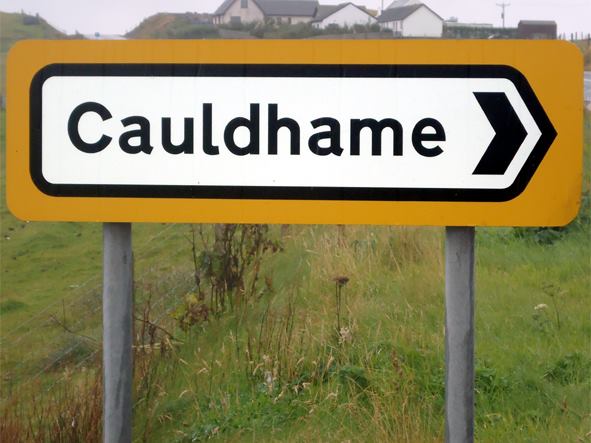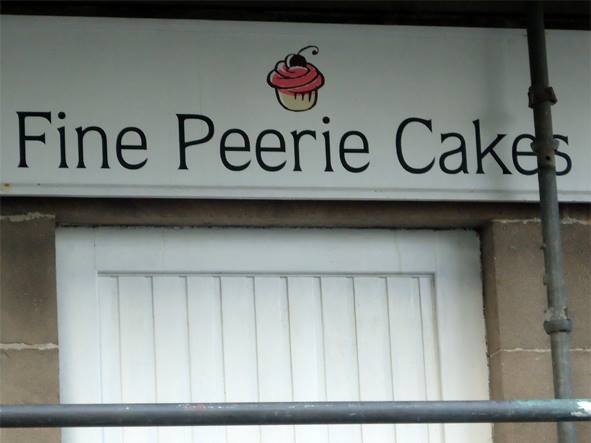Wir Ain Leed — Shetland Scots
Shetland Scots It is derived from the Scots dialects brought to Shetland from the end of the fifteenth century by Lowland Scots, mainly from Fife and Lothian, with a degree of Scandinavian influence from the Norn language, which was spoken on the islands until the late 18th century.
Consonants
The consonants not listed below usually have much the same phonetic values (pronunciation) in Shetland Scots, as in Standard English. For more detail see Orthography.
An initial <d> before a vowel may be pronounced /dj/ or even /ʤ/.
Initial <f> (/f/) may be pronounced /fj/ in words like fact, fauch and ferm etc.
Medial and final <ch> is usually /x/ in words such as bocht, nicht and loch.
Initial <ch> is usually /ʃ/ in words such as chap, chield, chirl, and chowk.
The cluster <nch> is usually /nʃ/ in words such as brainch, clinch, dunch, hainch, inch and French.
The trigraph <tch> is usually /ʧ/ in words such as fleetch and wratch.
The trigraph <dge> is usually /ʤ/ or /ʧ/ in wprds such as begrudge, cadge, cruldge and fadge.
The graphemes <g> and <ge> are occasionally /ʤ/ or or /ʧ/ in words such as breinge and gigot.
Initial <gn> is /gn/ among older speakers in words such as gnap and gnaw.
 Lerwick, Shetland
Lerwick, ShetlandInitial <kn> is /kn/ among older speakers in words such as knap, knee, knot and knowe.
Initial <j> is usually /ʧ/ in words such as Jean, jeely and jyle.
The cluster <ld> is usually /ld/, syllable final it may be simplified /l/, in words such as auld, bield, cauld, elder and fauld.
The cluster <nd> is usually /nd/, syllable final it may be simplified to /l/ in words such as baund, daunder, find, haund and sindry.
The digraph <ng> is usually /ŋ/ in words such as finger, hing, ingan and single.
The digraph <nk> is usually /ŋk/ in words such as bink and hank.
The digraph <qu> is usually /kw/, in Southern Shetland, after /s/ and /sw/, it may be /ʍ/, in words such as acquent, quair and queen.
The digraph <sh> is usually /ʃ/ in words such as creash and sheep. Occasionally that may be /ʒ/ in words such as fushion and pushion.
 Mainland, Shetland
Mainland, ShetlandThe digraph <th> is usually /d/ in words such as blether, buith, meith, sooth, thaim and thair and /t/ in words such as wirth, thing and thrawn. After a final vowel that may be /θ/ in, for example, mooth and truith.
The digraph <wh> is usually /ʍ/, around Lerwick it may be /kw/, in words such as wha, whan, wheech and wheel.
Initial <wr> is often /wr/ in words such as wrack, wrang, wricht and write.
Vowels and Diphthongs
Vowels in unstressed positions are usually /ə/ in words such as aboot, the, oxter, duntit, bannock and smeddum.
Initial <a> is usually /ə/ in words such as ahint and awa etc.
The grapheme <a> is usually /a/, in some areas /ɔ/ and /æ/, in words such as aff, lang, mak, wash and watch.
Final <a> is /aː/, in some areas /æː/, in words such awa, twa aw wha.
 Tondra, Shetland
Tondra, ShetlandInitial and medial <au> is usually /aː/, in some areas /æː/, before /l/ it may be /ɑː/ and on the Fair Isle before /x/ it may be /ɔː/, in words such as auld, haud, haund, saul, saund and slauchter.
Final <aw> is usually /aː/, in some areas /æː/, in words such as aw, blaw, caw, draw, faw, gaw, gnaw, haw, slaw, snaw and staw. That occasionally occurs word initial or medial in, for example, awn, awfu, bawbee and bawsant.
The digraph <aa> /aː/ is only used in a few words derived from Norn.
Initial and medial <ai> is usually /eː/, in the northern isles and in West Mainland also before /r/ it may be /ɛː/, on Whalsay after /k/ and /g/ it may be /je/, in words such as aiblins, aik, aiple, ait, aith, braid, craitur, fain, gaither, graith and haimer.
The cluster <a-e> is usually /eː/, in the northern isles and in West Mainland also before /r/ it may be /ɛː/, on Whalsay after /k/ and /g/ it may be /je/, in words such as alane, ale, ane, ance, bane, cake, face, gane, gate, hame, mane, nane, Pace and stane, however, in the northern Isles and Fair Isle the cluster <ane> may be /in/ in words such as alane, ane, bane, gane, mane, nane and stane.
Final <ae> is usually /eː/ in words such as ae, brae, f(r)ae, gae, sae, tae n. and wae. The <ae> is /ø/ or /Y/ in words such as adae, dae shae and tae v.
Final <ay> is usually /e/ in words such as day, gray and lay.
The digraph <ea> is usually /iː/ or /eː/, in short environments before /k/ it may be /ɪ/ and in some areas /ɛ/, in words such as beast, cheap, deave, east, heap, hear, meat, ream, sea and tea.
 Lerwick, Shetland
Lerwick, ShetlandThe digraph <ee> is usually /iː/ in words such as dee, dree, eetem, freet, jeelie, keep, meet, teeth, weel and weet.
The digraph <ei> is usually /iː, or eː/,in short environments before /k/ it may be /ɪ/, in some areas /ɛ/, in words such as beir, deid, heid, meidae, peir, spreid, teir, threid. Before /x/, <ei>, is /i/ in words such as dreich, heich and skeich.
The digraph <ie> is usually /i/ in words such as bield, chield, scrieve and shielin.
The grapheme <e> is usually /ɛ/ or /ɛ(ː)/, in the outer isles it may be diphthongised, in words such as bed, ebb, esh, fecht, gled, gless, seck and wecht.
 Bixter, Shetland
Bixter, ShetlandThe grapheme <i> is usually /ɪ/, before /ʃ/ and /x/ it may be /əi/ or /ae/, in words such as drink, fish, in, inch, licht, lift, nicht, pit, rin, simmer, sin, stibble, whin, whisper, whit, wid, wind, wir, wird, wirm and wittins.
The graphemes <o> and <oa> are usually /ɔ/, in some areas it may be /o/, on Yell before /x/ it may be /əu/, in words such as boat, boss, box, brocht, coal, cod, common, dochter, hoast, loch, on, rock and thocht.
The digraph <oo> is usually /uː/ in words such as aboot, coont, droop, hoose, moose, oot, scoor and soond.
The digraph <ou> is usually /uː/ in words such allou, bouk, broun, cour, coum, doun, dout, poupit and thoum.
The cluster <u-e> is usually /ø/ in words such as dule, hure.
The grapheme <u> is usually /ʌ/ in words such as bund, burn, drunken, fund, grund, truff, unce, and wund.
The digraph <ui> is usually /ø/ or /Y/ in words such as abuin, abuise, bluid, bruit, buird, cuil, cuit, duin, fluir, fruit, fuird, guid, luif, luim, muin, muir, muisic, ruise, schuil, shuir, spuin, uise, uiss and Yuil.
The digraph <eu> is usually /ø/, but also /Y/, /ju/ or /jɔ:/, in words such as beuch, beuk, eneuch, heuk, leuch, leuk, neuk, sheuch, teuch and teug.
The digraph <ew> is usually /ju/ in words such as dew, few, new and spew.
The clusters <i-e> and <y-e> are usually /əi/ in words such as advice, bide, bile, fine, fire, ile, rive, tyne, wise adj. and wyte.
Initial <ey> is usually /əi/ in words such as eyntment and eyster.
Final <y> and <ye> is usually /ai/ in cry and kye etc.
The digraphs <oi> and <oy> are usually /ɔe/ in words such as Boid, foy, noise and ploy.
Initial and medial <ow> is usually /ʌu/, in some words /u/ or /ɔ/, in words such as bowt, cowp, cowt, gowd, gowf, lowp and owsen. Root final that is <owe> in words such as flowe, glowe, growe, howe, knowe, lowe, rowe and towe.
Suffixes
Strictly speaking not a suffix, <ae> is usually /ə/, in some words /u/ or /ɔ/, in words such as Americae, airae, barrae, nairae, swallae and windae.
Diminutive <ie> is usually /i/ in words such as grannie, laddie, lassie, shappie and wifie.
Adjectival <fu> is usually /fu/ in words such as awfu, carefu and mensefu.
The negative particle <na> is usually /nə/ in words such as daena (dinna), haesna, maunna, winna and wisna.
Adverbial and adjectival <y> and <ie> is usually /i/ in words such as reekie, sairy, stany and stourie.
Adverbial <ly> is usually /li/ in words such as brawly, feckly, fully, geyly, likely and uncoly.
The perfect and past perfect tenses are formed with the verb tae be rather than the verb tae hae i.e.
I'm buin at da fyshin.
(A'm been at the fishin.)
A hae been at the fishin.
I have been fishing.
Dey wir buin at da fyshin.
(Thay war been at the fishin.)
Thay haed been at the fishin.
They had been fishing.
Background information about Shetlandic at  Imbuis ta Shaetlan.
Imbuis ta Shaetlan.
Explore Shetland dialect at Shetland for Words.
An attempt to treat Shetland as as language in its own right with the main ancestor languages Norn and Scots: I Hear Dee.
Literature:
Robertson, T. A. and Graham, J. (1952) Grammar and Usage of the Shetland Dialect, Lerwick: Shetland Times Ltd.
Graham, J. (1984) The Shetland Dictionary, Lerwick.
Tait, John (2000) "Some characteristics of the Shetlandic vowel system", Scottish Language 19 , 83-99.
